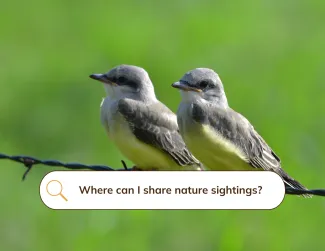
Sharing the details of your nature sightings can be a lot like skipping the perfect rock across the water. Documenting the specific what, when, and where details can help you remember your wild encounters … help fellow naturalists plan their next adventure … and help biologists design their next survey or study.
Just as it takes time to find the perfect rock for skipping, it takes time to find the right nature sharing app or site for your needs. We’ve highlighted four of our favorite sites below but encourage you to study the features of the individual sites and their privacy statements before giving them a test run.
iNaturalist (App Store/Google Play)
If you’re interested in sharing sighting details for a variety of organisms (a bird observation one day, a plant observation the next, and a turtle observation a week later…), iNaturalist is a great “where to share” candidate. After creating a free account, you can add observation details from their website or mobile app, share notes beyond the standard “what, when, and where” fields, and search for sightings made by other iNaturalists in your area. As an added bonus, iNaturalist automatically recommends species identifications when you upload a photograph with your observation. Members of the iNat community may also recommend identifications once the observation is posted. Learn more about iNaturalist’s features in their “Getting Started” guide.
- Not quite ready to upload and share details of your nature sightings? Consider using “Seek by iNaturalist.” (App Store/Google Play) Your observations and photos won’t be posted on iNaturalist, but you’ll still get automated recommendations for species identifications. Seek is a great iNaturalist alternative for younger children and classrooms.
eBird (App Store/Google Play)
Similar to iNaturalist, eBird documents the important “what, when, and where” details of your sightings. But where iNaturalist documents all organisms, eBird focuses only on bird sightings. This hub for birders has two primary features: 1) submitting your list of bird sightings, and 2) exploring the sightings made of individual species or at birding “hot spots.” This exploration feature is accessible without logging in, but you will need to create a free account to upload your bird lists and photos, and to access other features. While eBird is especially helpful for experienced birders, it can also help new birders by generating an area’s expected species list and show when to expect certain birds in certain areas.
- Want to take your birding adventures to the next level? The Cornell Lab of Ornithology shares a list of once-a-year and extended bird counts you can join; ways you can help study nesting success and nature in cities and towns; and plugs a photo and audio archive that helps document the planet’s bird life.
EDDMapS (App Store/Google Play)
The Early Detection and Distribution Mapping System, EDDMapS, is all about finding, mapping, and tracking invasive species. After creating a free account, you’ll be able to share sighting details of invasive plants, insects, fungi and diseases, and wildlife, which can help biologists track their spread. EDDMapS also searches through other databases, including iNaturalist, to provide a broader look at the invasion. Documenting and mapping observations is just one side of EDDMapS – land managers and naturalists can also learn more about the invasive plants and animals they may be concerned about and the ecological threats they present.
- EDDMapS is a great one-stop-share for invasive species, but the Wildlife Department also accepts reports of Aquatic Nuisance Species including mussels, snails, fish, plants, and crayfish.
Odonata Central (App Store/Google Play)
Just as eBird focuses solely on birds and EDDMapS focuses solely on invasive species, Odonata Central focuses solely on members of the “Odonata” insect order that includes dragonflies and damselflies. Like many other nature sharing sites, Odonata Central allows you to upload your observations, search and filter their extensive database for other sightings, and view their records on a map for free. Bar charts have also been generated to show the flight seasons of various species.
- Some of Oklahoma’s first dragonfly and damselfly records were collected by a Bluffton, Indiana banker in 1907 … which means nature enthusiasts have been helping shape the story of Oklahoma’s fish and wildlife for more than a century without being biologists by trade. Read more about how E.B. Williamson’s legacy lives on in our Outdoor Oklahoma Journal, and discover more about Oklahoma’s dragonfly history in “Dragonflies at a Biogeographical Crossroads.”
While you're searching for the best nature sharing site for you, don’t forget that the Wildlife Department welcomes sightings, especially of rare species.
Find more opportunities to share your nature sightings and get involved in conservation in this list of projects from National Geographic or by conducting your own search of local citizen science projects.